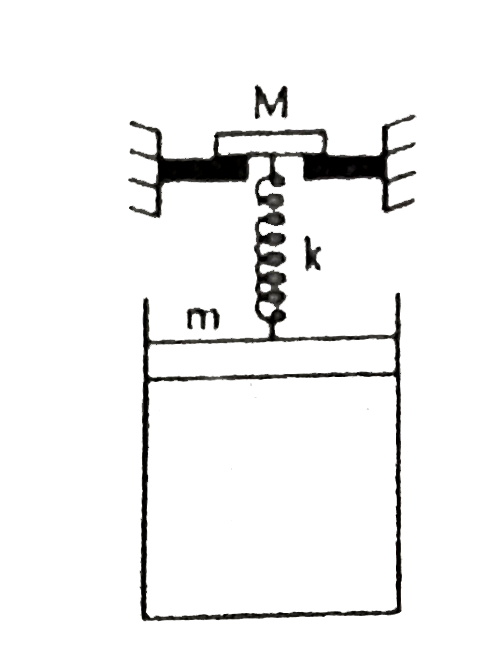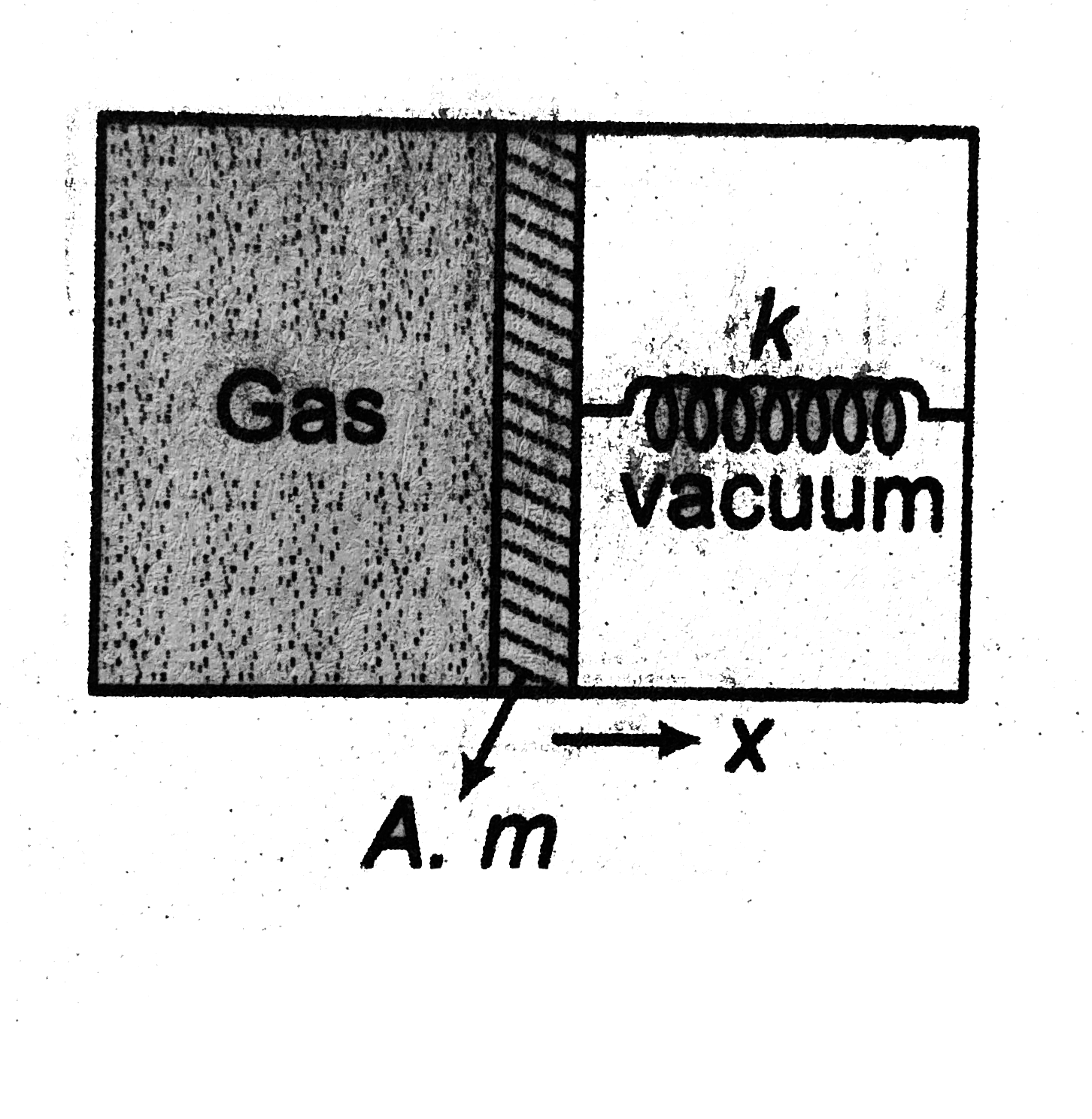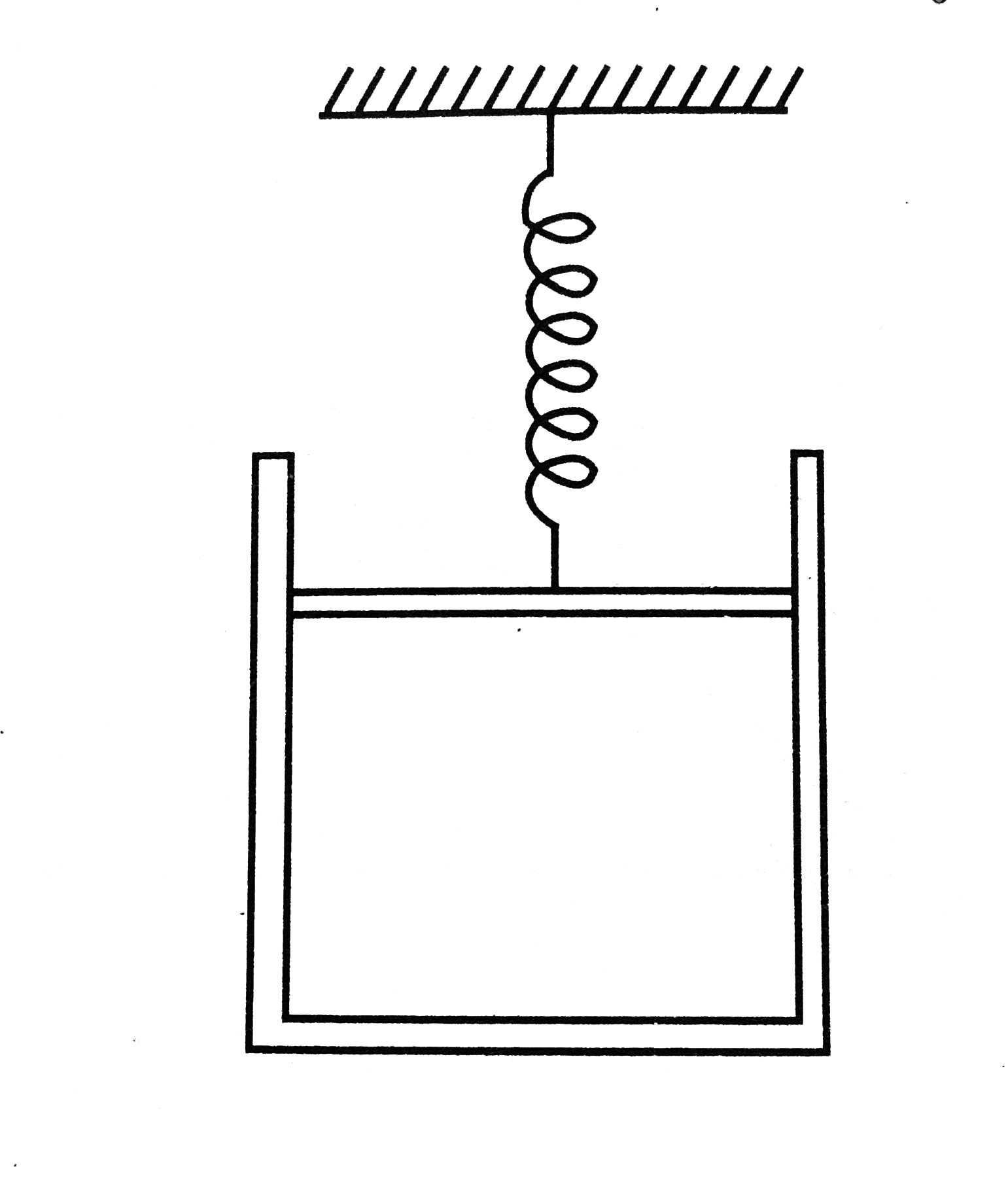0.01 moles of an ideal diatomic gas is enclosed in an adiabatic cylinder of cross-sectional area A=10−4m2 In the arrangement shown, a block of mass M=0.8 kg is placed on a horizontal support, and piston of mass m=1 kg is suspended from a spring of stiffness constant k=16N/m Initially, the springs is relaxed and the volume of the gas is V=1.4×10−4m3 When the gas in the cylinder is heated up the piston starts moving up and the spring gets compressed so that the block M is just lifted up. Determine the heat supplied (in Joule) Take atmospheric pressure P0=105Nm−2,g=10m/s2

The correct Answer is:0075 J
ΔV=f2nRΔT=52(P2V2−P1V1)=63 J
mgx+12kx2+P0Ax=ωgas
Ωgas=12j⇒ΔQ=75J
Topper's Solved these Questions
- MASTER PRACTICE PROBLEMBOOK - BANSALCHAPTER - MASTER PRACTICE PROBLEMEXERCISE - Additional topic
70 Videos
- MASTER PRACTICE PROBLEMBOOK - BANSALCHAPTER - MASTER PRACTICE PROBLEMEXERCISE - Multiple objective
131 Videos
- FLUID MECHANICSBOOK - BANSALCHAPTER - FLUID MECHANICSEXERCISE - PYQS AIEEE
10 Videos
- SEMICONDUCTORSBOOK - BANSALCHAPTER - SEMICONDUCTORSEXERCISE - CBSE Question
32 Videos
Similar Questions
a block of mass 0.1 kg attached to a spring of spring constant400Nm pulled horizontally from x=0 tox1=10mm. Find the work done by the spring force
View SolutionMethod 3 of W
Mass of a piston shown in Fig. is m and area of cross-section is A. Initially spring is in its natural length. Find work done by the gas.

View Solution
Knowledge Check
a block of mass 0.1 kg attached to a spring of spring constant400Nm pulled horizontally from x=0 tox1=10mm. Find the work done by the spring force
A2⋅10−2JB2⋅10−6JC3⋅10−6JD4⋅10−2JWhen a mass of 1 kg is suspended from a spring, it is stretched by 0.4m. A mass of 0.25 kg is suspended from the spring and the spring is allowed to oscillate. If g=10m/s2, then its period of oscillation will be
A0.5 secB0.4 secC0.628 secD1.5 secAn ideal monoatomic gas is enclosed in a fixed horizontal adiabatic cylinder of cross sectional area A. The cylinder is fitted with an adiabatic piston of mass m (attached to one end of a spring as shown) which can move horizontally without friction inside the cylinder. In equilibrium, the spring is in natural length and pressure and volume are P0 and V0 respectively. The piston is slightly displaced from equilibrium and released. Then, frequency of small oscillation is
 A12π√km+53P0A2mV0B12π√km−53P0A2mV0C12π√53P0A2mV0−kmD12π√km
A12π√km+53P0A2mV0B12π√km−53P0A2mV0C12π√53P0A2mV0−kmD12π√km
Method 3 of W
Mass of a piston shown in Fig. is m and area of cross-section is A. Initially spring is in its natural length. Find work done by the gas.

View SolutionAn ideal monoatomic gas is enclosed in a fixed horizontal adiabatic cylinder of cross sectional area A. The cylinder is fitted with an adiabatic piston of mass m (attached to one end of a spring as shown) which can move horizontally without friction inside the cylinder. In equilibrium, the spring is in natural length and pressure and volume are P0 and V0 respectively. The piston is slightly displaced from equilibrium and released. Then, frequency of small oscillation is

View SolutionAn external unknown horizontal force F pulls a smooth block of mass m attached with an ideal spring of stiffness k. Block is initially at rest and spring is relaxed. Find the work done (in J) by the force F, when the block moves with a velocity v and the deformation of the spring is x (k = 25 N/m, v = 1 m/s, m = 1 kg, x =20 cm)
View SolutionAn ideal gas has a volume 0.3m3 at 150kPa. It is confined by a spring-loaded piston in a vertical cylinder. Initially, the spring is in relaxed state. If the gas is heated to a final state of 0.5m3 and pressure 600kPa find the work done on the spring (atmospheric pressure, P0=1×105N/m2).

View SolutionAn ideal gas has a volume 0.3m3 at 150kPa. It is confined by a spring-loaded piston in a vertical cylinder. Initially, the spring is in relaxed state. If the gas is heated to a final state of 0.5m3 and pressure 600kPa find the work done on the spring (atmospheric pressure, P0=1×105N/m2).

View Solution
